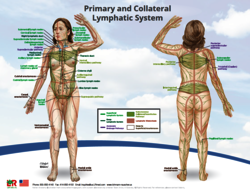What is Lymphedema?
Lymphedema is a swelling that occurs when a blockage in your lymphatic system prevents the lymph fluid from draining adequately throughout the body.
Your lymphatic system is crucial to keeping your body healthy. It circulates protein-rich fluid throughout the body, collecting bacteria, viruses, and waste, flushing them from your system. Lymphedema is a chronic swelling that occurs when a blockage in your lymphatic system prevents the lymph fluid from draining adequately (most often occuring in arms or legs, although it can happen anywhere). You can see a detailed look at a typical lymphatic system by clicking on the poster below.
Who is at Risk for Lymphedema?
Some people are born with lymphedema (known as primary lymphedema), although it's usually caused by damage to the lymphatic system (known as secondary lymphedema).
Primary lymphedema is pretty rare and typically affects women, usually in their legs. It's an inherited condition that's caused by problems with the development of the body's lymph system. The most common cause of primary lymphedema are:
- Milroy Disease (congenital lymphedema), a malformation of the lymph nodes that begins at infancy.
- Meige Disease (lymphedema praecox), a hereditary condition that causes lymph vessels to form without valves. Meige's typically begins during childhood or puberty.
- Late-Onset Lymphedema (lymphedema tarda), a rare condition that usually occurs after the age of 35.
Secondary lymphedema is more common than primary lymphedema and is typically caused by:
- Surgery can cause lymphedema to develop if lymph nodes or vessels are removed, damaged, or severed during surgery. For instance, lymph nodes are sometimes removed during surgery for breast cancer to determine if the cancer has spread, which may result in lymphedema if the remaining nodes aren't able to compensate.
- Cancer cells or tumors growing near lymph nodes or vessels can cause blockages, preventing the lymph fluid from draining properly.
- Radiation Treatment may cause scarring or inflammation of the lymph nodes or vessels, restricting lymph flow.
- Infections or Parasites can also compromise the lymph system. This type of lymphedema (filarial lymphedema) is most commonly found in tropical regions from around the world such as India, China, or Indonesia.
- Injury that damages lymph nodes or vessels may also compromise the lymph system, causing lymphedema.
If you feel that you may be at risk for lymphedema, please see your therapist or doctor for more information and view the National Lymphedema Network's paper on Lymphedema Risk Reduction.
What are Symptoms of Lymphedema?
Symptoms of lymphedema can include:
- Prolonged swelling of part of your body (typically in your arm or leg)
- A feeling of heaviness or tightness in the suspected area
- Restricted range of motion
- Aching, pain, or discomfortRecurring infections
- Hardening, reddening, and / or thickening of the skin
If you notice any of these symptoms or suspect that you might have lymphedema, please see your therapist or doctor for more information.
Can I Prevent Lymphedema?
There are no guarantees when it comes to preventing lymphedema, however, there are still significant steps that you can take to reduce your chances of developing it. If you're at risk for secondary lymphedema, first and foremost be sure to talk about a care and prevention plan with your medical professional. Secondly, you may want to look at these general guidelines as well:
- Monitor the 'at-risk' area. Keep an eye out for abnormal swelling, and changes in sensation, color, or skin condition.
- Maintain a normal body weight. Obesity may increase your risk of developing lymphedema.
- Protect the 'at-risk' area. Try to avoid injury to the area, including fractures, cuts, burns, blood draws, or vaccinations. Instead, ask to have medical procedures (such as blood draws or vaccinations) performed in a limb that is not at risk.
- Exercise. Before beginning an exercise routine, check with your medical professional.Avoid tight clothing.
- Avoid tight clothing. Avoid anything that could constrict the 'at-risk' area, such as tight fitting clothing.
- Keep your arm or leg clean. Make skin care and nail care high priorities.
Is Lymphedema Treatable?
Unfortunately there isn't a cure for lymphedema just yet, but it can still be treated and managed. The following are some of the most common treatment methods for lymphedema. As always, talk with your medical professional before beginning any treatment plan.
- Massage. A special massage called Manual Lymphatic Drainage is often used to move lymph fluid around blocked areas to help reduce swelling.
- Exercises. These are usually light or remedial exercises specially used to help manage lymphedema.
- Compression. Compression can come in several forms, such as short-stretch bandaging or compression garments.
- Support groups. While support groups aren't used to physically treat lymphedema, they can help provide other forms of comfort and relief that are equally as important. You can find support groups in your area at the National Lymphedema Network's website.

